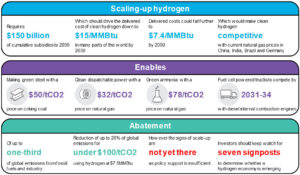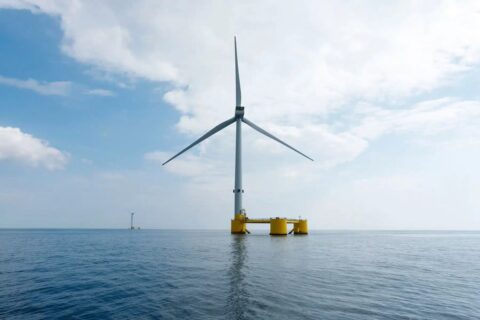
Cost-competitive with natural gas and better than coal, clean hydrogen could help tackle the toughest third of global greenhouse-gas emissions by 2050, but only if net-zero goals and policies are set.
Hydrogen Economy Outlook, a new and independent global study from research firm BloombergNEF (BNEF), finds that clean (or green) hydrogen could cut up to 34% of global greenhouse-gas emissions from fossil fuels and industry, when deployed in decades to come. Moreover, it could do so at manageable cost, but, only if policies are put in place to boost technology and capacity, so creating economies of scale.
The report’s findings suggest that renewable hydrogen could be produced for $0.8 to $1.6/kg in most parts of the world before 2050. This is equivalent to gas priced at $6-12/MMBtu, making it competitive with current natural gas prices in Brazil, China, India, Germany and Scandinavia on an energy-equivalent basis. When including the cost of storage and pipeline infrastructure, the delivered cost of renewable hydrogen in China, India and Western Europe could fall to around $2/kg ($15/MMBtu) in 2030 and $1/kg ($7.4/MMBtu) in 2050.
Kobad Bhavnagri, head of industrial decarbonisation for BNEF and lead report author, said:
“Hydrogen has potential to become the fuel that powers a clean economy. In the years ahead, it will be possible to produce it at low cost using wind and solar power, to store it underground for months, and then to pipe it on-demand to power everything from ships to steel mills.”
Cleaning up as costs go down
Hydrogen is a clean-burning molecule that can be used as a substitute for coal, oil and gas in a large variety of applications. However, for its use to have net environmental benefits, it must be produced from clean sources, rather than unabated fossil fuel processes, as is typical today.
With its act cleaned up, the falling cost of making hydrogen from wind and solar power then offers a promising route to cutting emissions in some of the most fossil fuel dependent sectors of the economy, such as steel, heavy-duty vehicles, shipping and cement.
Renewable hydrogen can be made by splitting water into hydrogen and oxygen, using electricity generated by cheap wind or solar power. The cost of the electrolyser technology to do this has fallen by 40% in the last five years, and can continue to slide if deployment increases. Clean hydrogen can also be made using fossil fuels if the carbon is captured and stored, but this is likely to be more expensive.
Storage infrastructure an issue
Storing and moving hydrogen is challenging. For hydrogen to become as ubiquitous as natural gas today, a huge, coordinated programme of infrastructure upgrades and construction would be needed. For instance, 3-4 times more storage infrastructure would need to be built at a cost of $637bn by 2050 to provide the same level of energy security as natural gas. However, cost-efficient large-scale options do exist and could be used to supply industrial customers.
The study found that a carbon price of $50/tCO2 would be enough to switch from coal to clean hydrogen in steel-making by 2050; $60/tCO2 to use hydrogen for heat in cement production; $78/tCO2 for making chemicals like ammonia; and $145/tCO2 to power ships with clean fuel, if hydrogen costs reach $1/kg. Heavy trucks could also be cheaper to run on hydrogen than diesel by 2031, although batteries still benefit cars, buses and light trucks.
For hydrogen to gain use, policy is critical, concludes Bhavnagri:
“The clean hydrogen industry is currently tiny and costs are high. There is big potential for costs to fall, but the use of hydrogen needs to be scaled-up and a network of supply infrastructure created.
“This needs policy coordination across government, frameworks for private investment, and the roll-out of around $150bn of subsidies over the next decade. That may sound daunting but it is not, in fact, such a huge task — governments around the world currently spend more than twice that every year on fossil fuel consumption subsidies.”
With a team of experts spread across six continents, BloombergNEF (BNEF) is a leading provider of primary research on clean energy, advanced transport, digital industry, innovative materials, and commodities. BNEF is powered by Bloomberg’s global network of 19,000 employees in 176 locations, reporting 5,000 news stories a day.
* Image source BNEF: Clean hydrogen refers to both renewable and low-carbon hydrogen (from fossil-fuels with CCS). Abatement cost with hydrogen at $1/kg (7.4/MMBtu).
Further Reading:
- View/Download the Key Messages from the Hydrogen Economy Outlook (PDF).
- More about BloombergNEF (BNEF).
>>> Do you have sustainability news to broadcast and share? If you would like to see it featured here on SustMeme, please use these Contact details to get in touch and send us your Press Release for editorial consideration. Thanks.






